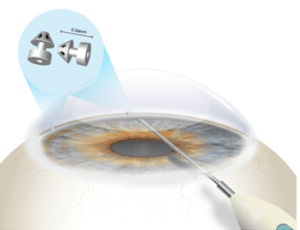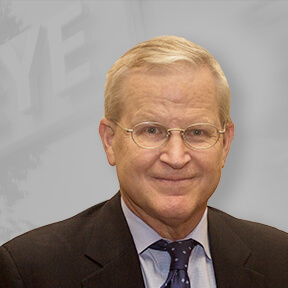JONATHAN S. MYERS, MD
Chief, Glaucoma Service
iStent: A Procedure to Lower Eye Pressure Alongside Cataract Surgery
When a person with glaucoma is planning to have cataract surgery, an iStent procedure to help control the eye pressure may also be considered. Implanting iStents along with cataract surgery may allow the patient to stop using one or more glaucoma eye drops. Expected recovery for combined iStent and cataract surgery is nearly the same as the recovery for cataract surgery alone. Large studies have found the iStent to be very safe for those who qualify for the surgery.
How does the iStent work?
The iStent device is made of two tiny tubes. Each iStent is about the size of one letter on the face of a penny. The iStent creates a path that allows the fluid inside the eye to bypass the natural drain of the eye. Reduced drainage is one reason that high eye pressures can develop in glaucoma. The iStent procedure is approved to be performed only in conjunction with cataract surgery. It is believed that cataract surgery alone may reduce pressure in some patients.
What are the steps of surgery?
 The surgery is performed in the operating room. Your eye will be numbed with eye drops and numbing jelly. The anesthesiologist will give you medications through your IV to keep you relaxed and calm during surgery. The eye is cleaned and the face will be covered with a sterile drape. An instrument opens the eyelids. Tiny incisions for cataract surgery are made in the front of the eye. The iStent is placed through these same incisions. A special lens is placed on the eye to look at the eye’s natural drain, and the microstents are placed in the drain. The iStent procedure adds about 15 extra minutes to the surgery.
The surgery is performed in the operating room. Your eye will be numbed with eye drops and numbing jelly. The anesthesiologist will give you medications through your IV to keep you relaxed and calm during surgery. The eye is cleaned and the face will be covered with a sterile drape. An instrument opens the eyelids. Tiny incisions for cataract surgery are made in the front of the eye. The iStent is placed through these same incisions. A special lens is placed on the eye to look at the eye’s natural drain, and the microstents are placed in the drain. The iStent procedure adds about 15 extra minutes to the surgery.
What will I feel during the surgery?
You may see bright lights during the surgery, but should not feel pain. You may be asked to move your eyes in different direction for placing the stents in the eye.
What happens to the eye after surgery?
The iStents start draining fluid as soon as they are placed. This lowers the eye pressure, and in some patients one or more glaucoma medications may be stopped after surgery. You will be discharged with a clear plastic shield with or without a patch over the operated eye. An adult will need to drive you home since you received sedating medications.
How often will I be seen after surgery?
You will see your doctor the first day after surgery, about a week later, and a few weeks after that. Depending on how your eye heals, additional or fewer visits may be needed.
What eye drops will I use after surgery?
Most patients will be asked to use a steroid and antibiotic eye drops. The frequency of the taking the steroid eye drops depend on the amount of the eye inflammation.
Request an Appointment TODAY
If you would like to speak with a Wills Eye representative for help finding a glaucoma physician
CALL 215-928-3197


JOEL S. SCHUMAN, MD
Co-Director

L. JAY KATZ, MD
Emeritus Director

ELIZABETH DALE, MD

JASON FLAMENDORF, MD

LAUREN E. HOCK, MD


NATASHA KOLOMEYER, MD

DANIEL LEE, MD

LINDSAY MACHEN, MD

MARLENE R. MOSTER, MD

MICHAEL PRO, MD


REZA RAZEGHINEJAD, MD

MARY JUDE COX, MD

RACHEL NIKNAM, MD

JESSE RICHMAN, MD

GEOFFREY SCHWARTZ, MD

COURTLAND SCHMIDT JR., MD

ALICE WILLIAMS, MD

Can I stop my glaucoma drops after surgery?
Your doctor will tell you which drops to continue using and how often at each visit depending on how your eye is doing. Sometimes patients are able to reduce the number of eye drops they are taking. Even if you are taking the same glaucoma medications after the procedure, the surgery is a success if your pressure is lower. The need for eye drops long-term after this treatment varies greatly and depends on your type of glaucoma and the rate at which it is progressing.
Will my vision improve right after surgery?
The first few days after surgery, vision may be blurry. This will improve over 1-2 weeks, although it can sometimes take longer. The eye that was not operated on will not be affected, and may be depended on for vision during the recovery period (if it has vision).
What is the recovery time and what should I expect?
Depending on your job and your other eye, you should be able to return to work within a few days to a few weeks. Limitations in physical activities at work may be needed. After surgery, your eye may be sore, and it may feel like there is something in it, like an eyelash. The drops may burn when you put them in, and your eye may water or tear a lot. These symptoms are common but usually are mild, and improve for most people after 1-2 days. Tylenol (acetaminophen) is a good option unless you are unable to take this medication. If your eye has severe pain or sudden worsening pain or vision after surgery, please call our office or on call physician immediately.
Will I have any restrictions after surgery?
You will be given detailed instructions after your surgery that are specific to your eye’s needs. In general, the following guidelines apply:
- The plastic shield should be worn while sleeping for 1 or more weeks after surgery to protect the eye.
- While outside during the day, sunglasses should be worn to protect the eye from the sun and wind.
- For the first few weeks, avoid strenuous activities (running, lifting more than 10 pounds), bending, rubbing the eye, wearing eye makeup, and swimming.
- There are no restrictions in reading, watching TV, using your phone, tablet device, computer, etc but you may tire more easily during these activities.
What are the possible side effects of iStent surgery?
iStent surgery is considered a very low risk addition to cataract surgery. However, no surgery has zero risk, and possible complications are the same as those encountered in cataract surgery: infection, bleeding in the front or back part of the eye, need for additional surgical intervention, and other eye surgery complications.
Will iStent cure my glaucoma?
The simple answer is no. Glaucoma is a chronic disease that requires constant monitoring and treatment. The iStent procedure will help to lower your eye pressure. However, it will not reverse any loss of vision that has already occurred.
What happens if the implant does not work?
Clinical trials and our own experience have shown that glaucoma medications or an additional procedure may be needed over time after iStent surgery. This depends on what is considered a “safe” pressure for your eye, how much your eye scars, the type of glaucoma you have, and more. After your surgery, your doctor will monitor you closely so we can adjust therapy if needed.
For more information, please see:
American Academy of Ophthalmology Patient Information Website:
https://www.aao.org/eye-health/diseases/what-is-glaucoma
American Glaucoma Society Patient Information Website:
https://www.americanglaucomasociety.net/patients/patient-education
